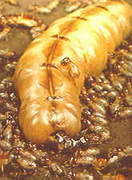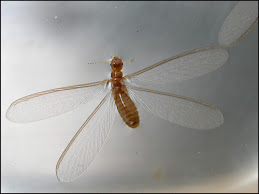Swarming of winged termites marks the start of the monsoon season
Take heed of winged termites (gamu-gamu or simut-simut Ilk) swarming in early evening in lighted homes and streets. Swarming means new termite colonies are in the making! Your home may be vulnerable.
Dr Abe V Rotor
Termites are among the most enigmatic creatures. They are also among the oldest, older than the dinosaurs, and virtually have not changed. Thus they are considered living fossils.
What is more amazing is their life cycle and behavior as social insects. To ordinary observers it is a case of "now you see, now you don't." For in most part and time of their lives, they are ensconced in mounds, crevices and tunnels of wood and earth incognito to the busy world.
Here they form colonies in thousands, governed by a royal couple, with the queen tremendously enlarged compared to the king and the castes, the workers and the soldiers. And her task is to lay eggs daily to maintain the colony to as long as twenty years.
Protect your home from termites.
- Keep your home and surroundings clean, free of termite food such as pile of leaves, stock of firewood, old clothes, paper, unserviceable furniture, etc.
- Check regularly the presence of termites in your home - floor, ceiling, bookshelves, rooms, even in unlikely places like apparador and piano. Repair, and trace source of invasion. Early detection is crucial.
- Treatment with chemicals may be necessary. Consult an authorized pest controller. Keep in mind that pesticides pose danger to health and environment.
- Dig out termite mound (punso) around the house, in the garden and field. Be sure to destroy the queen, otherwise the mound will grow back.
- At the start of swarming, put off the lights in your home so that the swarm dissipates or moves away into the open. Coordinate with neighbors to do the same.
- Where swarming is heavy, place a basin of water around a lighted bulb or lamp. Gather trapped insects for feeds or simply discard properly.
- Saw off stumps and limbs of trees. Tree termites live in the hollow of trees, and standing dead trees.
- Knock down abandoned buildings which are a source of invasion. Effective termite control is a community effort.
- Observe Integrated Pest Management (IPM) where biological control and good farming practices work effectively. Examples: house lizard and toads feed on gamu-gamu, flood control and proper tillage reduce termite population.
- Dismiss subtly superstitious beliefs and fairy tales of dwarfs living in anthill (punso) without taking away the quaintness of bedtime stories. Termites have no place in ouir dwellings. They belong to the forest to keep the balance of nature, recycling dead trees and litters back into soil.
- Avoid loud metallic music at home and vicinity. This stimulates termites to feed and make tunnels aggressively, according to recent research.
Termite queen is surrounded by workers and soldiers, with the king on top. The king is a bit larger than any member of the castes. Right, winged termites swarm in early spring in temperate countries, or at
the start of the rainy season in the tropics.
Closeup of the soldier, worker and immature members. Winged termite showing two pairs of wings of the same size and pattern (unlike most winged insects), from which its order Isoptera (same wings) is derived.
Left, dry termites live entirely on wood with very little moisture. Right,
termitecomb, a complex maze of undigested and digested wood, earth
and frass (excreta) serves as a complex tunnel and abode of the colony.
Its architectural design keeps the structure ventilated and light, but strong and firm in shape. In the case of wood, the termitecomb keeps it to appear undamaged until it finally gives in to stress and gravity.
How high and massive can a termite mound (punso) get? This one in Africa.is for the Book of Guinness Right, cross-section of a mound showing the queen's chamber, chimneys and ramifying tunnels. A mound grows in size through time and as the colony increases. The queen may live up to 20 years, and is capable of rebuilding the mound. In certain societies the queen is dug out
and made into a delicacy.
Basin full of gamu-gamu trapped by lamp, a practical method of gathering gamu-gamu for animal feeds and also as human food. Photo taken at author's residence in San Vicente (IS) 2017.
Cu Chi Tunnel in Vietnam, a complex underground tunnel of the Vietnamese resistance against the French colonialists and Vietcong guerillas during the Vietnam War extends several kilometers linking major strongholds. It houses underground command centers, dormitories, armories, and hospitals. The Cu Chi tunnel owes much of its design from that of the termites. Left, map of the Cu Chi Tunnel complex, author waves at well-wishers before exploring the man-made maze. Right, author points to ventilation system of the tunnel appearing as natural termite mound. Team finds great relief upon emerging from the hot, steamy tunnel. ~












No comments:
Post a Comment